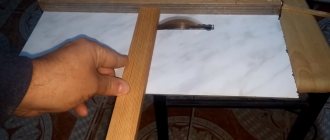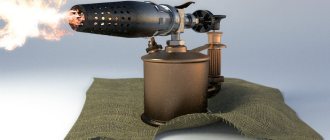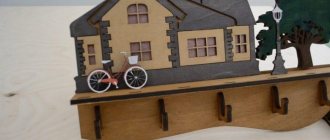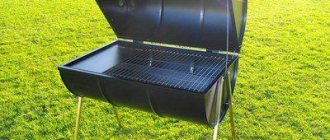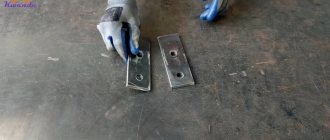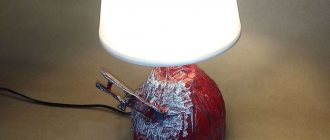During construction work, such as pouring a foundation, making a floor, or installing an armored belt, reinforcement is often used. When carrying them out, the question may arise: how to bend the reinforcement so that it does not lose its strength? Many novice builders try to heat the bend angle or cut the rod at the bend site, but both approaches negatively affect the strength characteristics of the metal. The main assistant in solving this problem is often a do-it-yourself reinforcement bending machine.
What is a reinforcement bender?
This is a homemade technical tool that helps to bend reinforcement of any diameter without losing the strength of the rods.
Photo and description
As you can see from the photographs, the design of reinforcement benders consists of two main elements - a stop and a movable roller part (rod). Machines can be manual or mechanical.
If in the first case the work is carried out exclusively with the help of a person, then in the second the bending of the reinforcement is carried out due to an electric drive. Factory settings are usually made for a specific type of rod, which is indicated on the marking of the machine. However, you can make an effective mobile reinforcement bender from simple improvised means yourself.
Application area
Bending machines can significantly speed up various construction processes. They are widely used in the following areas:
- Pouring a reinforced concrete foundation. In this case, the reinforcement bender is used to bend rods when creating a frame;
- Creation of a strip foundation. Bending machines are used for precise bending of reinforcement at a given angle;
- Bending hinges, clamps or metal rings. The device is used in cases where metal cannot be bent manually due to its thickness.
Step-by-step instructions for creating a do-it-yourself reinforcement bender
To design a bending machine, it is necessary to go through a number of stages.
- Selection of drawing.
- Preparatory work.
- Assembly.
Each of them requires a clear understanding of the purposes for which the use of this equipment is required, as well as the competent distribution of allocated funds.
Selection of drawing
There is no point in reinventing the reinforcement bender, since many different drawings can be found in the public domain on the Internet that allow you to create effective, time-tested structures. This will simplify the search for the necessary materials, calculate cost estimates, select tools, and also allow you to estimate the amount of time for production.
An example of a drawing of a reinforcement bender with a bearing.
At the same time, it is worth understanding that you need to create a tool only for specific purposes, and not make it universal and, as a result, never use this functionality. If subsequently there is a need to expand functions, then it is better to use it later, having laid down a sufficient margin of safety for this.
Preparatory work
At the preparation stage, you need to decide on the following points:
- Decide for what purposes the reinforcement bender will be used.
- Select a drawing of the desired design. Make changes if necessary.
- Purchase materials.
- Select tools for assembly.
If the budget is limited, then in this case it is possible to create a lever design of the machine at the initial stages, and subsequently equip it with a hydraulic drive. It is important to create a machine base in which the safety margin will exceed the same parameter for the fittings by 3-5 times. Such data can be found from tables in reference books, so there should be no problems with this point.
Selection of tools
To create a reinforcement bender you must have the following tools:
- an angle grinder (builders call it a “grinder”) with a set of cutting and grinding discs for metal;
- electric drill with a set of metal drills;
- semiautomatic welding machine with a set of suitable electrodes;
- hammer, pliers, file, core;
- vice.
The use of power and hand tools is required to ensure high machining productivity as well as accurate part fitting.
Necessary materials
To create bending machines you will need:
- Steel corner with a side width of 75 mm, a length of 800 mm, a metal thickness of 5 mm.
- Steel rod with a diameter of 12 to 25 mm.
- Bolts with a diameter of 20 mm and a length of 50 mm, as well as washers for them.
- Additional devices, for example, a hydraulic drive, if its installation is provided for by the design.
It is important to create a massive structure that will ensure the stability of the machine when bending and applying force.
2 options for manufacturing a machine for bending reinforcement
The following designs of homemade reinforcement benders are considered the most popular:
- From the corner.
- From a bearing.
Corner machine
The procedure for making a device for bending reinforcement from a corner:
- The corners are cut to size as indicated in the drawing.
- The steel U-shaped profile is cut so that its length is 1 m. It will serve as a bed.
- A pin made of thick reinforcement is welded to the frame in the middle.
- We cut off a piece of pipe whose diameter allows it to be placed on the welded pin.
- A corner is welded perpendicular to the welded pin. Then a hole is drilled in it for the internal diameter of the pipe.
- The corner with the pipe is put on the pin. Then mark the place for welding the corner piece, remove the moving part and weld the second part of the corner.
- A piece of reinforcement is welded to the end of the movable structure. It will act as a lever. You need to attach a comfortable handle to the end opposite to the mount.
- Reinforcing legs are welded to the frame.
It is recommended to lubricate the bending axis to extend its service life by reducing friction of parts during operation.
There is a simpler design for a reinforcement bender made from a corner. You need 2 corners of 80 cm each, with a metal thickness of at least 5 mm. You will need studs, 3 pieces of 10-15 cm, and one 20 cm.
The procedure is as follows:
- We weld two pins to one of the corners, with the help of which we will attach the corner to the table.
- We weld a piece of tube on the edge to the second corner. This will be our moving part.
- We weld a pin to the other end of the corner. We put a piece of pipe on it and screw two nuts. This will be our handle.
The simplest, homemade machine for bending reinforcement from a corner.
Simplicity of design and mobility allow it to be transported from one construction site to another and attached to any table; the machine will be an excellent assistant in reinforcing strip foundations, floors and other reinforced concrete structures. This reinforcement bender allows you to bend reinforcement with a diameter of up to 14 mm.
Device for bending reinforcement with a bearing
The production of a machine from a bearing for bending reinforcement is implemented as follows:
- From a square pipe 40x40 mm it is necessary to cut a piece 300-350 mm long. Drill holes in it with a diameter of 12 mm for installing bolts for fastening.
- On one side you need to insert the nuts and weld them to the profile, and then make a cut to install the bushing for the bearings and weld it. It is important that the bushing is of the correct shape without defects or dents.
- In a piece of 40x40 mm profile, you need to make cuts to attach the bushing to the shock-absorbing rod. A lever made from a half-inch diameter pipe needs to be welded to it.
- From a 32x23 mm corner you need to cut a piece 250 mm long, and then weld it to the profile with a small allowance of 15 mm for structural reliability. Then you need to insert a support made of a steel strip.
- To create a movable limiter, a steel plate and a pin are used.
- The lever is welded to the base of the structure. After this, the bearings are inserted into place and the machine is assembled.
Before operation, you need to check the functionality of the structure on steel rods with a diameter of up to 10 mm. Only after this can maximum loads be applied.
Operating principle of a reinforcement bender
All reinforcement benders, regardless of the material from which they are made, work on the same principle: the reinforcement rod is placed in the gap between the movable roller and the stop. The rotating part of the machine bends the rod in the required direction and at the required angle.
Important! The moving roller must ensure bending at a maximum angle of 90 degrees, otherwise the metal rod will lose strength.
Reinforcement bending - process features
At any construction site today you can see various equipment, many tools and devices, and almost every one of them has a machine for bending reinforcement. This is no coincidence: the most effective technology for strengthening fragile concrete structures, protecting them from destructive loads in compression, tension and bending, is reinforcement, which is performed using metal rods - reinforcement. Without a high-quality reinforcement frame, it is almost impossible to build reliable concrete walls and foundations.
Professional equipment capable of bending reinforcement of a very decent diameter looks like this.
It would seem much easier to reinforce corner concrete structures and adjacent wall areas using straight reinforcing bars. However, in this case, the concrete structure will be greatly weakened and may delaminate. In addition, this is a gross violation of building codes. In any corner concrete structures, it is necessary to use only bending, with an overlap of at least 80 cm on each side. A machine or a simple device for bending metal rods is also useful if you need to quickly produce connecting elements of various types - hooks, claws, etc.
And this is a simple homemade solution, mounted on a floor slab right on the construction site.
When bending steel bars used for reinforcement, it is very important to know how to bend foundation reinforcement so that it does not lose its strength characteristics. To comply with this requirement, it is necessary to perform such an operation only mechanically, using special machines for cutting and bending reinforcement. In this case, it is important to ensure that the bend angle is not sharp, and that the radius of curvature at the bend is from 10 to 15 diameters of the rod itself. It should be remembered that a steel reinforcing bar bends without losing its strength characteristics up to an angle of 90 degrees, then the strength indicators begin to decrease.
If you don’t have the time or desire to deal with homemade products, then purchasing a similar ready-made bender would be a good way out.
When bending steel reinforcing bars with your own hands, two mistakes are often made:
- a notch is made at the bend site using a grinder or other tool;
- The section of the reinforcement where the bend will be located is heated using a gas burner or blowtorch.
After such procedures are completed, some primitive means for bending is used: a heavy hammer, a sledgehammer, a piece of pipe, a vice, etc. These bending methods lead to a significant weakening of the reinforcement, which can cause the destruction of concrete structures. In such cases, you should always remember that you need to bend the reinforcing bars without violating their integrity and only if they are in a cold state.
In general, everything here is expensive and serious - full automation and many settings. For home craftsmen, this video is provided for informational purposes only. Since spending 130-180 thousand rubles on such a unit for non-professional use does not make any sense.
Photos of homemade machines
Here are some examples of rebar benders made at home.
Machines and devices for bending reinforcement
In the process of development of construction technologies and metal processing methods, more than one machine for bending reinforcement was created. All such equipment works on the same principle; the difference between the models consists only in certain design features and the maximum diameter of the bending rod.
Any bending machine, including a homemade machine for bending reinforcement, works on the following principle: the rod is fixed between two rollers (central and thrust), and with the help of a third roller (bending), the reinforcement is bent at the required angle. Conveniently, the machine for bending metal reinforcement can bend a rod both to the left and to the right. The required bending radius is ensured by the thrust shaft, thanks to which the reinforcement does not deform along its entire length.
One of the options for a homemade machine, consisting of two parts - movable (lever) and fixed (base)
Drawing of the moving part
Fixed part drawing
An example of how ordinary nails can be used to quickly measure the distance between the bends of rods.
Machines designed for bending reinforcement, including those made by yourself, can be of two types:
- manual;
- with mechanical drive.
The main working element of mechanically driven machines is a rotating disk on which the bending and central fingers are fixed. There is a gap between these fingers, into which the rod to be bent is placed. The reinforcement placed in this gap rests at one end against a roller rigidly fixed to the device body. As the disc rotates, the bending pin acts on the reinforcement and bends it around the central shaft.
Manual bending machine AFACAN 16PT (price approximately 5,500 rubles). One of the models of this particular Turkish manufacturer was mentioned in the video at the beginning of this article
A specific machine for bending reinforcement, depending on its purpose, may belong to one of the following groups:
- light (for bending rods with a diameter of 3 to 20 mm);
- heavy (diameter of processed rods - from 20 to 40 mm);
- extra heavy (for fittings with a diameter of 40 to 90 mm).
Power driven equipment can be used to bend multiple rebar bars at the same time. Modern industry produces machines that can be used for bending rods whose diameter ranges from 3 to 90 mm. For those cases where it is necessary to bend reinforcement at different angles, it is best to use hydraulically driven equipment. Such a universal machine for bending reinforcement allows you to obtain a bending surface without cracks and folds, which can lead to the formation of internal stresses. This equipment also makes it possible to adjust the bending angle to 180 degrees.
On the modern market, you can optimally select a machine for bending various types of reinforcement, including portable ones, which are easy to use and affordable. Bending of reinforcement can be done either using special equipment or using a pipe bender, which is installed on ordinary workbenches.
You can make such bending devices yourself. However, they are used for bars with a diameter of no more than 14 mm and are not intended for cases where high productivity is required. Most often, such devices are used in private construction.
Another variation of the bending machine: a channel as a base, two angles, an axis of rotation and a handle
When choosing equipment for quick bending of reinforcement, two main factors should be taken into account: the maximum diameter of the rod that needs to be bent and the volume of work to be done. When bending a rod, its parts are subjected to different loads: the outer surface is subjected to tension, and the inner surface is subjected to compression.
If you choose the wrong equipment, then folds and cracks may form on the processed bar (or it will collapse under the influence of significant loads). To prevent this from happening, it is necessary to correctly select and configure bending equipment, as well as ensure reliable fixation of the reinforcement being processed.
Industrial wire bending machines
In serial and large-scale production, machines that work with wire in coils are used. Such units provide cost-effectiveness and good productivity when producing metal products of the same type. Devices are installed on the machine, configured to obtain a specific configuration.
Work process:
- installing a coil of wire on the unwinder;
- a long product is affected by two mechanisms - roller and flat;
- the aligned wire enters the machine into bending devices;
- the part of the required configuration is cut off by a mechanical cutting device.
This type of wire bending equipment produces parts of simple shapes. The number of bending operations usually does not exceed 5.
CNC machines for wire bending: types and main characteristics
Technologically advanced machines are numerically controlled. They make it possible to obtain parts of complex shapes. To change the bending shape and size of the product, change the program on the computer.
There are several types of machines that operate using computer programs:
- With one bending console. This type of unit produces products that are simple in shape. The sweep length is limited to 1 m.
- With two consoles. With their help, metal products of complex configurations with long development lengths are produced. The work is done with wire cut into measured lengths. Bending is carried out in counter directions. On double-cantilever machines it is possible to obtain closed bends.
- Volumetric bending. 3D bending allows the production of complex three-dimensional shapes. The disadvantage of this technology is the high cost of the units and their inability to provide high performance. Such machines produce seamless products that will be subject to high demands on strength during operation.
The principle of bending reinforcement
The principle of operation of the bending machine is based on the fact that the reinforcement is firmly fixed (one or two ends) and, when pressed by the operator, reinforced by a lever or a system of levers, it is bent at the desired angle.
According to building codes, the bend angle of the rod must be such that the concrete in the finished reinforced concrete product is not damaged or crumbled at the bend site. The bending of the rod along a notch or under the influence of elevated temperature is not allowed - this will reduce the strength characteristics of the rod, and, as a result, the future structure. Reinforcement can only be bent “cold”. The simplest bending machine consists of two angles connected by a bolt. In the simplest, but not the most reliable, version, they don’t even need to be welded together.
Performing a bend
When bending, you must comply with construction regulations for a specific type of reinforcement: for example, the permissible bend angle A-III is 90 degrees, provided that the bend radius is not less than 6-8 rod diameters. If the reinforcing bar is bent by 180%, the strength will decrease by 10%.
Bending wire at home
To give simple shapes to not very stiff wire, use metalworking tools, available in almost every home workshop:
- Pliers . With their help, you can bend or securely fix the end of the product.
- Pliers . A type of pliers.
- Wire cutters . With their help, metal products are cut into measured pieces.
To create complex shapes, templates are used, which are checked against during the bending process. To bend a rectangular clamp, the end of the wire is clamped in a vice, and bending is carried out with pliers or hammer blows.
Safety rules for manual bending:
- work must be carried out wearing thick fabric gloves;
- it is necessary to ensure tight fixation of the material being processed;
- There should be no heavy objects on the table on which work is carried out that could fall to the floor.
How to bend reinforcement without a special device
Here it is worth knowing that when trying to bend, especially alloyed reinforcement, with your own hands you need to consciously calculate your actions, otherwise this can lead to serious injuries. Alloyed rolled metal, if you try to deform it, will try in every possible way to spring back and can cause irreparable harm to your health. So be careful and attentive.
Let us highlight the three simplest ways to bend reinforcement with a diameter of up to 8 mm yourself without the use of special devices, namely:
Using two pieces of metal pipe. So, we will need tubes with a diameter of 15 mm with a length of 0.5 and 1 meter, which we put on the fittings. We stand on a half-meter piece of pipe with our feet, and, accordingly, we begin to lift the meter piece to the bend angle we need.
- If a five-centimeter piece of pipe 25-32 mm in diameter is electric welded to a one and a half meter metal pipe of 32 mm in diameter or a 50 mm steel angle, you will get a universal bending lever. All that remains is to either stand on the reinforcement or rest it against something strong.
- Not very long pieces of reinforcement can be bent using a large vice and a sledgehammer. Only with this method you shouldn’t rush and you need to hit with a little force, stretching the process, otherwise you can simply break the reinforcing bar.
The main disadvantage of using such methods for bending reinforcement is that the turning radius is quite large and often the angle turns out to be somewhat curved and does not lie with its sides strictly in the same plane.
Tips and tricks for making rebar benders
When making a bending machine for reinforcement with your own hands, it is important to follow a number of tips and recommendations:
- All structural elements should be selected with a margin of safety. Saving on one of the parts can lead to a number of problems and require significant financial investments to restore the functionality of the reinforcement bender.
- Before starting work, you need to make sure that the parts are assembled correctly and are securely fastened.
- It is recommended to use parts made of alloy or tool steel, as they can withstand significant loads and ensure the maximum possible durability of the machine.
- It is important to decide in advance on the type of design so that it provides the necessary functionality. It is not possible to make alterations in the future in all cases, and manufacturing several machines is not always financially profitable.
Despite the apparent simplicity of the design of the machine, its assembly should be taken seriously. The parts must be adjusted as closely as possible to avoid problems during operation and rejection of the reinforcement.
You can make a reinforcement bender with your own hands without any problems. Its cost, even taking into account the time spent on creation and the purchase of materials, will be tens of times lower than the purchase of a machine made industrially. It will cope with its tasks in the same way, but at the same time, knowing its design, you can easily repair and maintain it, and, if necessary, even improve the design.
Source

